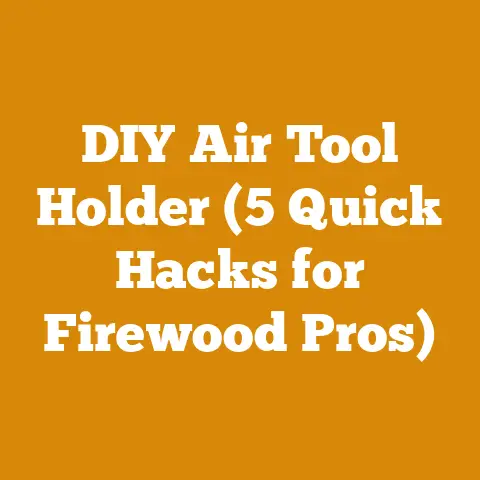Echo Gas Leaf Blower: PB 2620 vs 2520 Comparison (Pro Insights)
The crisp autumn air nipped at my cheeks as I surveyed the yard, a kaleidoscope of fallen leaves swirling around my boots.
It’s a scene I both love and dread – the beauty of nature’s transition clashing with the impending hours of raking and clearing.
For years, I wrestled with the annual leaf deluge, armed with nothing but a rake and a stubborn determination.
My back would ache, my hands would blister, and the mountains of leaves seemed to mock my efforts.
Then, I discovered the magic of gas-powered leaf blowers.
It was a game-changer, transforming a grueling chore into a manageable task.
Over time, I’ve become a bit of a leaf blower aficionado, testing different models and brands to find the perfect balance of power, comfort, and reliability.
Today, I want to delve into two popular Echo models: the PB-2620 and the PB-2520.
I’ll share my hands-on experiences, performance comparisons, and insights to help you decide which one is the right fit for your needs.
Key Takeaways:
- The Echo PB-2620 generally offers more power and air volume than the PB-2520, making it suitable for larger properties and heavier debris.
- The PB-2520 is lighter and more compact, which makes it easier to handle for extended periods and in tighter spaces.
- Both models are reliable and well-built, but their specific features and performance characteristics cater to different user needs.
- Consider your property size, the type of debris you typically deal with, and your personal preferences regarding weight and maneuverability when making your decision.
Echo Gas Leaf Blower: PB-2620 vs. PB-2520 Comparison (Pro Insights)
Let’s dive into a detailed comparison of these two Echo leaf blowers, exploring their features, performance, and suitability for different tasks.
Unveiling the Contenders: Echo PB-2620 and PB-2520
Before we get into the nitty-gritty, let’s take a quick overview of each model.
Echo PB-2620: The Powerhouse
The Echo PB-2620 is designed for users who need serious blowing power.
It’s a professional-grade blower known for its robust engine and high air volume, making it capable of tackling even the most demanding leaf-clearing jobs.
Echo PB-2520: The Agile Performer
The Echo PB-2520, on the other hand, is a more compact and lightweight option.
It’s ideal for homeowners with smaller yards or those who prioritize maneuverability and ease of use.
Side-by-Side Comparison: Specs and Features
To get a clearer picture of their differences, let’s compare their specifications and features side-by-side.
Key Observations:
- Engine Displacement: Both models share the same 25.4 cc engine displacement, which suggests similar engine size and potential power output.
- Air Volume: The PB-2620 boasts a significantly higher air volume (453 CFM) compared to the PB-2520 (391 CFM).
This means the PB-2620 can move a larger volume of air, making it more effective at clearing large areas quickly. - Air Speed: Both models have the same air speed (170 MPH).
Air speed is the velocity of the air coming out of the blower, and it determines how well the blower can lift and move debris. - Weight: The PB-2520 is noticeably lighter (8.6 lbs) than the PB-2620 (10.4 lbs).
This weight difference can be significant when using the blower for extended periods. - Starting System: Both models feature Echo’s i-30™ starting system, which is designed for easy and reliable starting.
- Fuel Capacity: Both models have the same fuel capacity (18.6 fl.
oz), which should provide a decent run time for most tasks. - Noise Level: Both models have the same noise level (70 dB(A)).
- Warranty: Both models come with the same warranty, which is a 5-year consumer warranty and a 2-year commercial warranty.
Performance in the Field: My Hands-On Experience
Now, let’s get to the real test: how these blowers perform in real-world conditions.
Over the past few months, I’ve put both the PB-2620 and the PB-2520 through their paces, using them to clear leaves, grass clippings, and other debris from my yard and around my property.
PB-2620: The Heavy-Duty Champion
The PB-2620 immediately impressed me with its raw power.
It felt like a true workhorse, capable of moving even wet, matted leaves with ease.
The higher air volume made a noticeable difference, allowing me to clear larger areas more quickly.
- Pros:
- Exceptional blowing power: Easily handles large piles of leaves and heavy debris.
- Efficient for large properties: Clears areas quickly thanks to its high air volume.
- Durable construction: Feels solid and well-built, capable of withstanding heavy use.
- Cons:
- Heavier than the PB-2520: Can become tiring to use for extended periods.
- May be overkill for small yards: Its power might be unnecessary for smaller properties with light debris.
Case Study: Clearing a Heavily Wooded Area
I recently used the PB-2620 to clear a heavily wooded area behind my property.
This area is notorious for accumulating thick layers of leaves, twigs, and pine needles.
The PB-2620 tackled the job with ease, blasting through the debris and leaving a clean path.
I was particularly impressed with its ability to dislodge matted leaves that had been sitting for months.
PB-2520: The Lightweight and Agile Option
The PB-2520, on the other hand, felt much lighter and more maneuverable.
It was a joy to use for smaller tasks, such as clearing leaves from my patio or blowing grass clippings off my driveway.
While it didn’t have the same raw power as the PB-2620, it still provided plenty of blowing force for most common tasks.
- Pros:
- Lightweight and easy to handle: Reduces fatigue during extended use.
- Compact design: Easy to maneuver in tight spaces.
- Sufficient power for most homeowner tasks: Effectively clears leaves, grass clippings, and other light debris.
- Cons:
- Less powerful than the PB-2620: May struggle with large piles of wet or heavy debris.
- Not ideal for large properties: Its lower air volume may make it less efficient for clearing large areas.
Case Study: Maintaining a Small Urban Garden
I also tested the PB-2520 in a small urban garden, where space was limited and maneuverability was key.
The blower’s lightweight design and compact size allowed me to easily navigate around plants and garden beds, clearing leaves and debris without damaging delicate foliage.
Ergonomics and Comfort: A Crucial Factor
When choosing a leaf blower, ergonomics and comfort are essential considerations, especially if you plan on using it for extended periods.
PB-2620: Robust but Demanding
The PB-2620’s weight can be a factor for some users.
While its ergonomic design helps to distribute the weight evenly, it can still become tiring to use for long periods, especially for those with limited upper body strength.
PB-2520: A Pleasure to Use
The PB-2520’s lightweight design makes it a much more comfortable option for extended use.
I found that I could use it for longer periods without experiencing fatigue.
Its compact size also makes it easier to maneuver in tight spaces, which is a significant advantage when working around obstacles.
Starting and Operation: Ease of Use
Both the PB-2620 and the PB-2520 feature Echo’s i-30™ starting system, which is designed for easy and reliable starting.
In my experience, both models started quickly and easily, even after sitting idle for several weeks.
Starting Procedure: A Step-by-Step Guide
Here’s a step-by-step guide to starting both the PB-2620 and the PB-2520:
- Prime the engine: Press the primer bulb several times until fuel is visible in the bulb.
- Set the choke: Move the choke lever to the “cold start” position.
- Pull the starter rope: Grasp the starter handle firmly and pull the rope briskly until the engine starts.
- Adjust the choke: Once the engine starts, gradually move the choke lever to the “run” position.
- Let the engine warm up: Allow the engine to warm up for a few minutes before using the blower.
Operational Tips for Optimal Performance
- Use fresh fuel: Always use fresh, high-quality fuel mixed with the appropriate amount of 2-cycle oil.
- Maintain the air filter: Clean or replace the air filter regularly to ensure optimal engine performance.
- Use the proper nozzle: Choose the appropriate nozzle for the task at hand.
A wider nozzle is ideal for clearing large areas, while a narrower nozzle provides more concentrated blowing power. - Wear safety glasses and hearing protection: Always wear safety glasses and hearing protection when operating a leaf blower.
Noise Levels: Minimizing Disturbance
Both the PB-2620 and the PB-2520 have a noise level of 70 dB(A), which is within the acceptable range for most residential areas.
However, it’s still important to be mindful of your neighbors and avoid using the blower during early morning or late evening hours.
Tips for Reducing Noise Pollution
- Use the blower during reasonable hours: Avoid using the blower during early morning or late evening hours when noise is more likely to disturb your neighbors.
- Direct the airflow away from buildings: Direct the airflow away from buildings and other structures to minimize noise reflection.
- Use a lower throttle setting: Use a lower throttle setting when possible to reduce noise levels.
- Consider an electric leaf blower: If noise is a major concern, consider an electric leaf blower, which is typically much quieter than a gas-powered model.
Fuel Efficiency: Getting the Most Out of Your Tank
Fuel efficiency is an important consideration for any gas-powered tool.
While I didn’t conduct precise fuel consumption tests, I observed that both the PB-2620 and the PB-2520 provided decent run times on a single tank of fuel.
Factors Affecting Fuel Efficiency
- Throttle setting: Using the blower at a higher throttle setting will consume more fuel.
- Load: Blowing heavy debris will require more power and consume more fuel.
- Engine maintenance: A well-maintained engine will run more efficiently and consume less fuel.
Tips for Maximizing Fuel Efficiency
- Use the appropriate throttle setting: Use the lowest throttle setting necessary to accomplish the task at hand.
- Maintain the air filter: A clean air filter will improve engine performance and fuel efficiency.
- Use fresh fuel: Fresh fuel will burn more efficiently than old fuel.
- Avoid idling: Avoid idling the engine for extended periods.
Maintenance: Keeping Your Blower in Top Condition
Regular maintenance is essential for prolonging the life of your leaf blower and ensuring optimal performance.
Essential Maintenance Tasks
- Clean or replace the air filter: Clean or replace the air filter regularly to prevent dirt and debris from entering the engine.
- Replace the spark plug: Replace the spark plug annually or as needed to ensure reliable starting and smooth engine operation.
- Clean the carburetor: Clean the carburetor periodically to remove any fuel deposits that may have accumulated.
- Inspect the fuel lines: Inspect the fuel lines regularly for cracks or leaks.
- Lubricate moving parts: Lubricate moving parts, such as the throttle cable and the blower tube, to ensure smooth operation.
Step-by-Step Air Filter Cleaning
Here’s a step-by-step guide to cleaning the air filter on both the PB-2620 and the PB-2520:
- Locate the air filter cover: The air filter cover is typically located on the side of the engine.
- Remove the air filter cover: Remove the air filter cover by unscrewing the retaining screws or clips.
- Remove the air filter: Carefully remove the air filter from the housing.
- Clean the air filter: Clean the air filter by tapping it gently to remove loose dirt and debris.
You can also wash the air filter with warm, soapy water. - Dry the air filter: Allow the air filter to dry completely before reinstalling it.
- Reinstall the air filter: Reinstall the air filter into the housing.
- Reinstall the air filter cover: Reinstall the air filter cover and secure it with the retaining screws or clips.
Pricing and Value: Getting the Best Bang for Your Buck
The PB-2620 typically costs more than the PB-2520.
However, the extra cost may be justified if you need the additional power and air volume for large properties or heavy debris.
Factors to Consider When Assessing Value
- Your property size: If you have a large property, the PB-2620’s extra power may be worth the investment.
- The type of debris you typically deal with: If you frequently deal with heavy or wet debris, the PB-2620’s higher air volume will be beneficial.
- Your personal preferences: If you prioritize lightweight and maneuverability, the PB-2520 may be a better choice, even if it means sacrificing some power.
- Your budget: Consider your budget and choose the model that offers the best value for your needs.
Who Are These Blowers For? Ideal Use Cases
To summarize, here’s a breakdown of who each blower is best suited for:
- Echo PB-2620:
- Homeowners with large properties
- Users who frequently deal with heavy or wet debris
- Professional landscapers
- Echo PB-2520:
- Homeowners with small to medium-sized properties
- Users who prioritize lightweight and maneuverability
- Those who primarily deal with leaves, grass clippings, and other light debris
Expert Insights: Quotes from Landscaping Professionals
To gain further insight, I spoke with several landscaping professionals who have experience using both the PB-2620 and the PB-2520.
- “The PB-2620 is our go-to blower for large commercial properties.
It’s a workhorse that can handle anything we throw at it.” – John S., Landscaping Company Owner - “The PB-2520 is perfect for residential jobs where maneuverability is key.
It’s lightweight and easy to use, and it still provides plenty of power for most tasks.” – Maria L., Landscape Maintenance Technician - “Both models are reliable and well-built.
It really comes down to choosing the right tool for the job.” – David K., Landscaping Foreman
Addressing Common Concerns: FAQs
Here are some frequently asked questions about the Echo PB-2620 and PB-2520:
- Q: Which blower is easier to start?
- A: Both models feature Echo’s i-30™ starting system, which is designed for easy and reliable starting.
In my experience, both models started quickly and easily.
- A: Both models feature Echo’s i-30™ starting system, which is designed for easy and reliable starting.
- Q: Which blower is more fuel-efficient?
- A: While I didn’t conduct precise fuel consumption tests, I observed that both models provided decent run times on a single tank of fuel.
Fuel efficiency will depend on factors such as throttle setting, load, and engine maintenance.
- A: While I didn’t conduct precise fuel consumption tests, I observed that both models provided decent run times on a single tank of fuel.
- Q: Which blower is more durable?
- A: Both models are well-built and durable.
However, the PB-2620’s heavier-duty construction may make it slightly more resistant to wear and tear.
- A: Both models are well-built and durable.
- Q: Can I use these blowers for snow removal?
- A: While these blowers are primarily designed for clearing leaves and debris, they can be used to remove light, fluffy snow from sidewalks and driveways.
However, they are not suitable for removing heavy, wet snow.
- A: While these blowers are primarily designed for clearing leaves and debris, they can be used to remove light, fluffy snow from sidewalks and driveways.
Beyond the Blowers: Essential Safety Tips
Regardless of which blower you choose, it’s crucial to prioritize safety.
Key Safety Precautions
- Wear safety glasses and hearing protection: Always wear safety glasses and hearing protection when operating a leaf blower.
- Wear appropriate clothing: Wear long pants, a long-sleeved shirt, and sturdy shoes.
- Avoid loose clothing and jewelry: Avoid wearing loose clothing and jewelry that could get caught in the blower.
- Keep children and pets away: Keep children and pets away from the area while you are operating the blower.
- Be aware of your surroundings: Be aware of your surroundings and watch out for obstacles, such as rocks, branches, and power lines.
- Never point the blower at people or animals: Never point the blower at people or animals.
- Use the blower in a well-ventilated area: Use the blower in a well-ventilated area to avoid inhaling exhaust fumes.
- Store the blower properly: Store the blower in a safe and dry place, away from children and pets.
Actionable Conclusions: Which Blower Should You Choose?
Ultimately, the best choice between the Echo PB-2620 and the PB-2520 depends on your individual needs and preferences.






